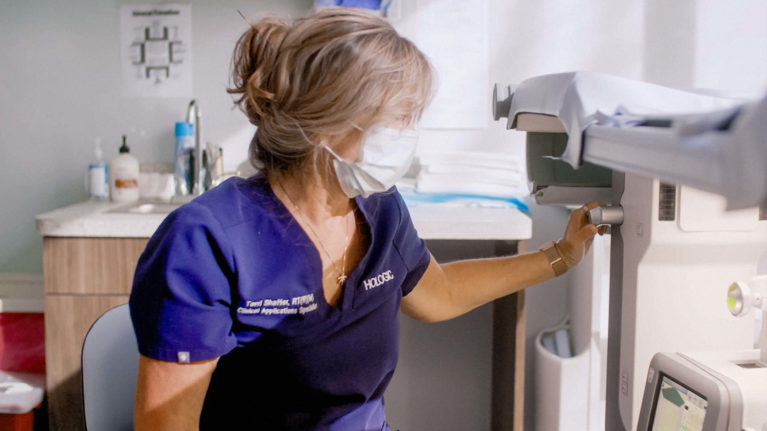Terri’s Story: “I’m Not Letting It Get My Spirit”

The fear of results, diagnosis, and your breasts getting squished—don’t let it control you. Take your power back by being even more diligent about your breast screening exams.
According to the American Cancer Society, when breast cancer is detected early and is in the localized stage, the survival rate is 99%.42 And getting regular breast mammograms is the most reliable way to find early symptoms of breast cancer.
Doing so can literally save your life.
Take it from Terri Shaffer, a Clinical Applications Specialist at Hologic. Early detection helped her beat cancer, not once but three times over.
From Mammographer to Breast Cancer Patient
As a radiologic technologist specializing in mammography, she’s been exposed to various surgical approaches and screening techniques for 40 years. Safe to say, she’s pretty accustomed to helping patients navigate the very personal changes that come with a breast cancer diagnosis. But nothing prepared her for when the roles were reversed and she was the one seeking cancer treatment.
One day at work, she and her colleagues decided to test out the new Genius® 3D Mammography™ machines on themselves. She went first.
The right breast scan came out beautifully. Moving on to the left breast, the very first image left everyone in shock. It was cancer.
![]()
Terri Schaefer
Clinical Applications Specialist at Hologic
“It’s an entirely different experience when you’re the tech taking the image, and you immediately know something is wrong just by looking at it.”
Terri was diagnosed with triple-negative breast cancer in her early forties, and her five-year survival rate was less than 50%.46
Triple-negative breast cancer is difficult to treat because it does not have any of the receptors that are commonly found in breast cancer. The growth of the cancer is not fueled by progesterone, estrogen, or by HER2 protein. That means cancer does not respond to otherwise “traditional” hormonal therapy medicines that target the HER2 protein receptors46. Terri immediately elected to have a mastectomy on her right breast and just be done with it.
A New Diagnosis: ER/PR Positive
This diagnosis made her even more diligent about her breast health. So 18-months later, she was back at the doctor’s office for her routine mammogram. Unfortunately, her left breast scan showed more calcifications—calcium deposits that when spotted in tight clusters or irregular shapes may indicate breast cancer.47
Her scan showed it was yet another cancer. But this time, she was diagnosed with ER/PR-positive cancer, meaning that it was hormone receptive. Unlike her first diagnosis, this cancer had either estrogen (ER) or progesterone (PR) receptors, or both, which allowed for hormone therapy as a course of treatment.48
Because she kept up with her breast cancer detection exams, her doctor was able to find cancer early on and offer more treatment options. The consensus was to do another mastectomy followed by breast reconstruction surgery.
Breast Cancer, Metastasized
Six months after Terri’s second mastectomy, and almost two years after her first cancer diagnosis, she felt something strange under her arm. That morning, she went to work, got another screening exam done, and was on the biopsy table by lunchtime—once again.
“My 30-plus years of knowledge in the field didn’t prepare me for what I found out,” she says. It was a recurrence of the first cancer and it had metastasized. “I assumed that meant it was a death sentence for me.”
This time, chemotherapy and radiation were needed to save her life because triple-negative breast cancer is one of the hardest forms of breast cancer to treat. This form of cancer grows and spreads much faster than cancer with hormone-positive and hormone-negative statuses.
The Power of Positivity
Terri doesn’t believe she would’ve gotten through her three cancer diagnoses if it wasn’t for her family surrounding her with love and positivity. She even jokes that they would fight over who would take her to doctor’s appointments. Through it all, she always had someone with her and now advises other women to do the same. She says:
One thing that I always tell women that I’m helping battle breast cancer is to surround themselves with positivity, start a blog, take a notebook with you.
Even though she didn’t feel prepared for her triple diagnosis, it doesn’t mean other women have to feel the same way. Terri’s mission is to inspire patients to stay positive during their treatment phase. They often asked her what she would do if she was in their position. Little did they know she had been in that exact place, had been in their shoes, and had felt every single emotion they were feeling.
The Genius® 3D exam’s superior technology saved her life, and she wants to do the same for other women.
“Working for Hologic has been the best thing in my world. I absolutely love working for them,” she says. “They’re all about helping women. They support women. They empower women. If I was told that I won the lottery tomorrow, I would still work for Hologic.”
-
Hi, I’m Terri Schaefer. I’m a radiologic technologist specializing the mammography. I’ve been in this field for 40 years, and I’m currently working as a clinical application specialist with Hologic. Big surprise was the day that we went in for our new unit. We were having it installed.
So we decided, let’s do each other’s mammograms. I was the guinea pig. We did one side. It came up beautiful. We did the second side, and the first image that popped up, we just looked at it and our mouths follow up.
We knew immediately that it was a cancer. When you first hear that you have breast cancer, it’s bad. But when you’re the tech taking the image and nobody has to tell you, because as soon as you see the image you owe, I elected to just have a mastectomy and be done with it. But I didn’t have a mastectomy on the other side. So fast forward.
Here I am. 18 months later, one of my routine mammograms on the opposite side, we see some more calcifications pop up and it comes back as another cancer. So now I had elected for another mastectomy and reconstruction. Six months later, I was in taking a shower and I felt something strange that felt like scar tissue. So once again, I call my doctors.
They get me in immediately for a biopsy. Same day again, my 30 plus years of knowledge in the field didn’t prepare me for what I found out. It was a recurrence of the first cancer. And so I assumed that that meant it was a death sentence for me. I pretty much collapsed where I was at least tell everybody if you let it get your spirit and it wins.
Views and opinions expressed herein by third parties are theirs alone and do not necessarily reflect those of Hologic. The content in this piece is for information purposes only and is not intended to be medical advice.
MISC-07978



